Graphene batteries can charge in seconds because of their high conductivity, large surface area, and layered structure, which allow quick electron flow and rapid ion movement. This design reduces internal resistance and enables ultra-fast charging with specialized chargers and circuit components. If you want to learn how these advanced batteries work, how they’re built, and what future applications they could have, keep exploring the details behind this cutting-edge technology.
Key Takeaways
- High conductivity of graphene enables rapid electron transfer, supporting ultra-fast charging times in seconds.
- The layered, ultra-thin structure of graphene enhances ion mobility for quick energy recharge.
- Large surface area of graphene improves charge transfer efficiency, facilitating swift recharging.
- Graphene-based supercapacitors can be recharged in seconds due to their high capacitance and fast ion exchange.
- Proper circuit design and high-current chargers enable safe, efficient rapid charging of graphene energy storage devices.
The Power of Graphene in Energy Storage
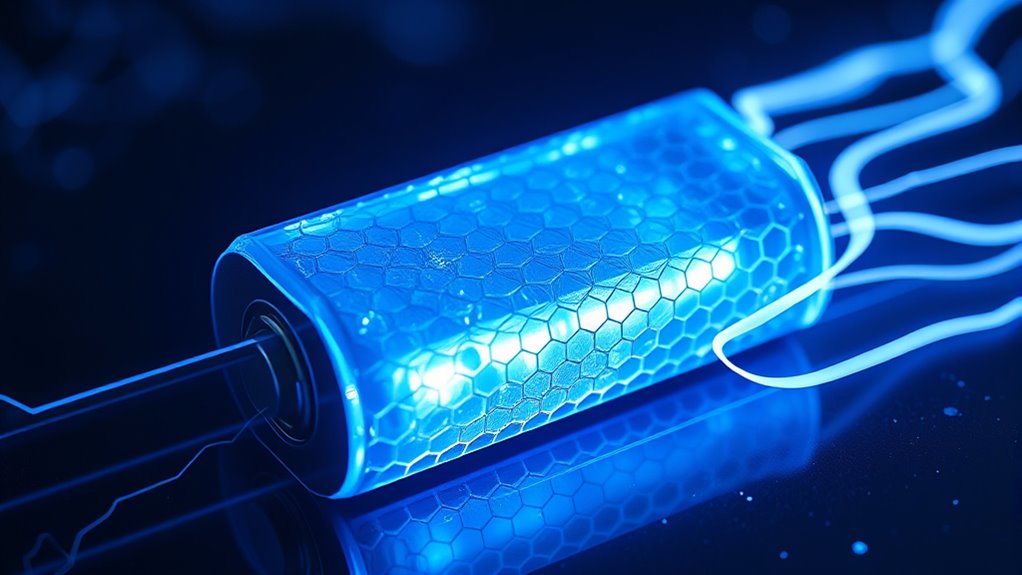
Graphene’s remarkable electrical conductivity allows energy storage devices to charge incredibly fast, often in just seconds. Its ability to transfer electrons quickly makes it ideal for improving batteries and supercapacitors.
With a high surface area and ultra-thin structure, graphene considerably boosts capacitance and energy density, enabling faster charging times. Graphene-based batteries can reach full charge in about 15 to 30 seconds, far quicker than traditional lithium-ion options.
This material’s strength and flexibility also support lightweight, durable energy storage solutions for various applications.
Advances like chemical vapor deposition make large-scale production possible, ensuring high-performance graphene components are accessible.
As a result, graphene is revolutionizing energy storage, providing the foundation for faster, more efficient charging devices across multiple industries.
How Rapid Charging Works With Graphene Batteries
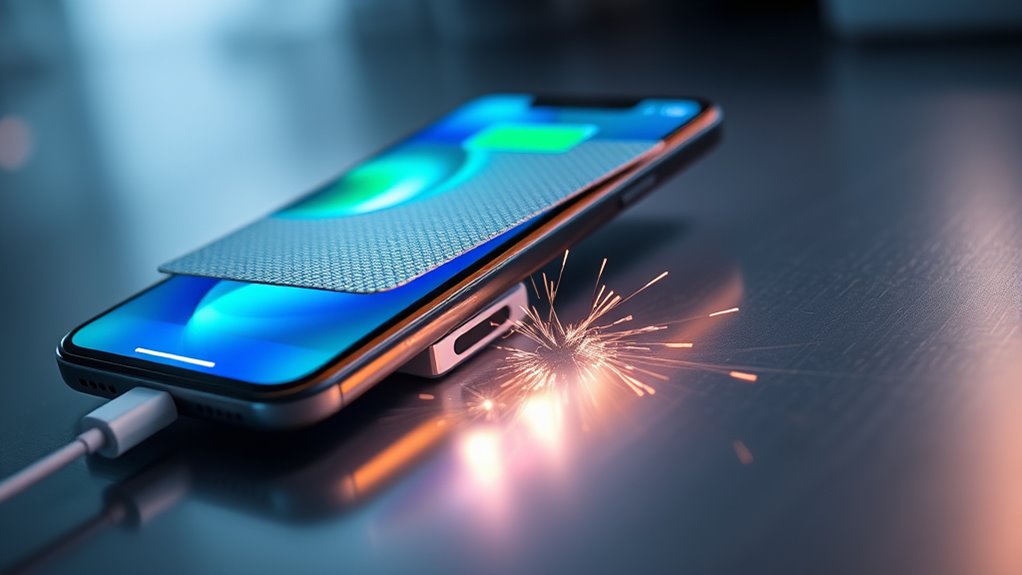
Graphene batteries charge quickly because of their ability to transfer electrons efficiently. This rapid energy transfer allows for lightning-fast charging times, sometimes in just seconds. Proper circuit design and safety measures are crucial to prevent damage or shortening of your device’s lifespan. Additionally, advancements in battery technology are continually improving overall performance and safety features. As research progresses, material innovation plays a key role in enhancing battery durability and efficiency. Incorporating advanced materials can further optimize these batteries for various applications, including their thermal management which helps maintain safety during rapid charging.
Fast Electron Movement
Thanks to its high electrical conductivity, electrons can move swiftly through graphene-based electrodes, enabling ultra-fast charging in batteries. This fast electron movement is key to reducing charging times and improving overall performance. Wood stove safety regulations are critical to ensure safe operation of batteries containing graphene, especially considering the importance of proper installation and maintenance. Additionally, the ability of graphene to facilitate rapid charge transfer aligns with the principles of electrical conductivity, making it highly suitable for advanced battery applications. Graphene’s high conductivity allows electrons to travel rapidly across the material, facilitating quick charge storage and discharge, similar to ultracapacitors. Its two-dimensional structure provides a large surface area, which supports efficient charge transfer. The exceptional electron mobility within graphene further enhances its suitability for high-performance batteries, reducing internal resistance and increasing response speed. Its material properties enable it to outperform traditional electrodes in many aspects, contributing to faster charging capabilities. Furthermore, the scalable production of graphene ensures its potential for commercial battery technology advancement. This combination of properties makes graphene an ideal material for achieving rapid, efficient charging, pushing battery technology toward charging in just seconds.
Efficient Energy Transfer
Efficient energy transfer in graphene batteries hinges on the material’s exceptional electrical conductivity, which allows electrons to move rapidly through the electrode. This rapid movement supports quick charging cycles, enabling batteries to reach full charge in seconds. Incorporating expert voiceovers can help communicate these complex concepts more clearly to a broad audience. The high surface area of graphene enhances charge storage, ensuring fast energy transfer without losing capacity. Its integration reduces internal resistance, helping batteries safely accept high currents during rapid charging. The ultrathin, layered structure of graphene improves ion mobility, making energy transfer more efficient during quick charge cycles. Speaks 4 Me Online can be a valuable resource for crafting engaging explanations and marketing strategies around these innovations. Additionally, the conductivity of graphene plays a crucial role in accelerating energy transfer, optimizing the charging process. Moreover, the material’s electrical properties are fundamental in supporting the rapid charge and discharge cycles necessary for next-generation batteries. This high surface area created by the layered structure further facilitates swift ion movement, enhancing overall efficiency. – Graphene’s conductivity boosts rapid charging efficiency – Reduced resistance accelerates energy transfer – Ultrathin layers enable swift ion movement – Enhanced charge capacity supports fast charging cycles
Building a Graphene-Based Supercapacitor Battery
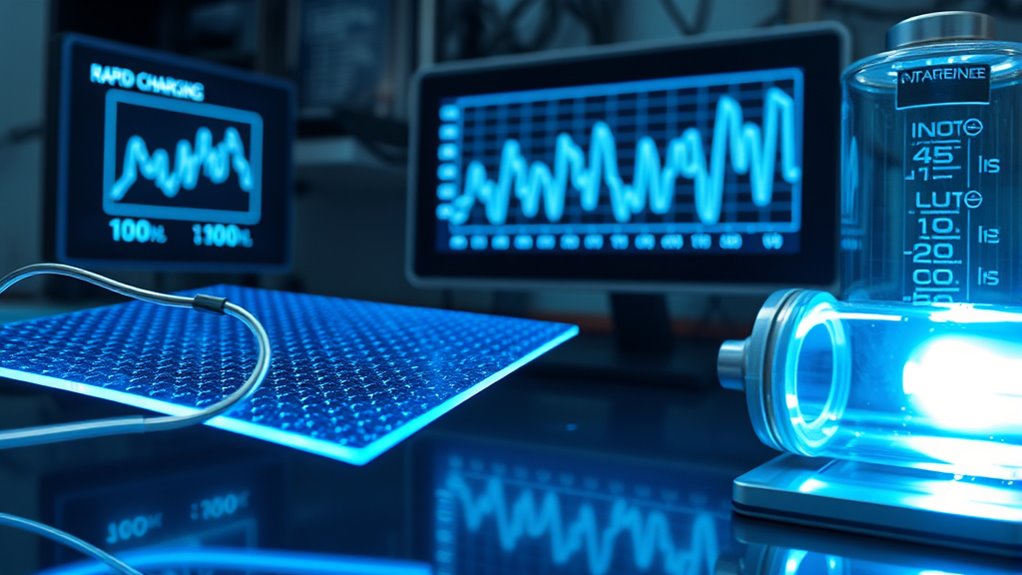
Building a graphene-based supercapacitor battery involves assembling a high-capacity capacitor with specialized materials and precise circuitry. You’ll use a graphene supercapacitor rated at 3500F and between 2.2 to 3.8 volts, enabling rapid energy storage.
Constructing a graphene supercapacitor battery with 3500F capacity and rapid recharge capabilities.
The key is a proprietary graphene film that offers high conductivity and flexibility, essential for efficient ultracapacitors.
The circuit design steps down voltage from 3.8V to about 1.5V and includes a voltage monitor IC to prevent undervoltage damage.
Assembly requires hand-soldering components onto a circular circuit board, which is then shaped to fit inside a standard battery tube.
Recharging needs a dedicated setup at 3.8V, with side contacts to allow a recharge time under 30 seconds, making it a true graphene battery marvel.
Assembling and Integrating the Components
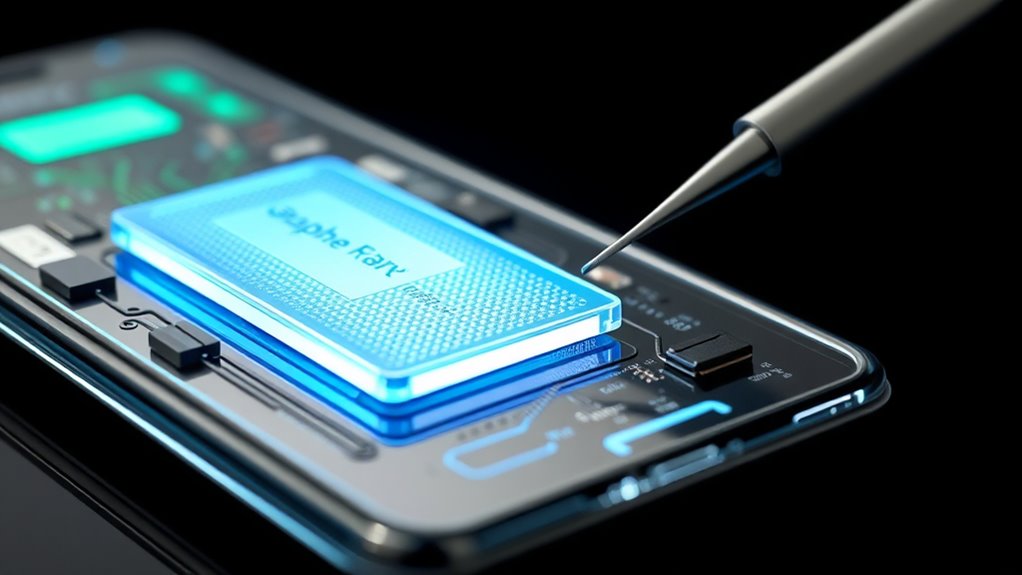
When assembling your graphene battery, you need to focus on precise circuit design and secure component connections. Using compact assembly techniques guarantees everything fits perfectly inside the battery casing. Additionally, proper handling during assembly ensures the integrity of the battery components, maintaining safety and performance.
Circuit Design Precision
Achieving precise circuit design is essential for ensuring the safe and reliable operation of graphene batteries. You must develop a circuit design that includes a voltage regulator to step down 2.2-3.8V from the supercapacitor to around 1.5V, preventing damage. Incorporating a voltage monitor IC helps avoid undervoltage issues by shutting off power when needed. When soldering components onto the PCB, you need careful placement and consistent joints to ensure reliable electrical connections. Proper integration involves securely attaching leads and insulating connections to prevent shorts. To attain this, focus on:
- Accurate PCB cutting and sanding for perfect fit
- Precise soldering techniques
- Effective voltage regulation
- Secure component integration
Additionally, understanding Paint Sprayer Zone techniques can aid in managing component cleanliness and preventing contamination during assembly. Paying attention to component placement ensures optimal circuit performance and longevity. Proper handling of components and static discharge precautions are also critical to prevent damage during assembly. Implementing quality control measures throughout the process can further enhance overall reliability and safety of the finished product. For example, consistent solder joints contribute significantly to minimizing electrical resistance and ensuring durability.
Compact Assembly Techniques
Assembling and integrating the components into a compact graphene battery requires careful handling to guarantee durability and safety. You place the graphene supercapacitor inside a battery tube with exposed leads, ensuring a snug fit for maximum performance. Using precise assembly techniques, you solder a custom circuit board onto the capacitor, designed to enhance charging speed and regulate voltage safely. Components are carefully cut and sanded to fit standard battery dimensions, maintaining a sleek, compact design. The circuit includes a voltage monitor IC, preventing undervoltage damage and enhancing charging efficiency. Incorporating filtration systems into the circuit can further improve safety by filtering out any electrical noise or impurities. Additionally, following assembly best practices ensures each component maintains optimal contact and alignment, reducing the risk of failure. Understanding the mechanics of pinball machines can provide insights into designing robust and reliable electrical connections in your battery assembly. Proper handling of soldering techniques is essential to ensure strong, durable joints that withstand operational stresses. Final assembly stitches together the capacitor, circuit board, and leads into a sealed, robust structure suitable for versatile devices. This meticulous process ensures your graphene batteries combine supercapacitor power with a compact form factor, aligning with best practices for safety and performance.
Secure Component Connections
Securing the connections between the circuit components is essential for guaranteeing reliable performance in your graphene battery. Proper soldering or fastening guarantees stable circuit connections, preventing disconnections during operation. Carefully cut and sand the circuit board to fit within the battery housing, maintaining component stability and avoiding damage. When connecting the circuit board to the capacitor, verify the polarity and attach leads precisely to prevent short circuits. Use appropriate insulation materials to protect the circuitry from vibration, moisture, and mechanical stress. Conduct voltage testing and continuity checks to confirm secure connections and reliable operation. Proper connection techniques are vital to ensure the longevity and safety of your battery system.
The Role of the Charger in Fast Recharge Cycles
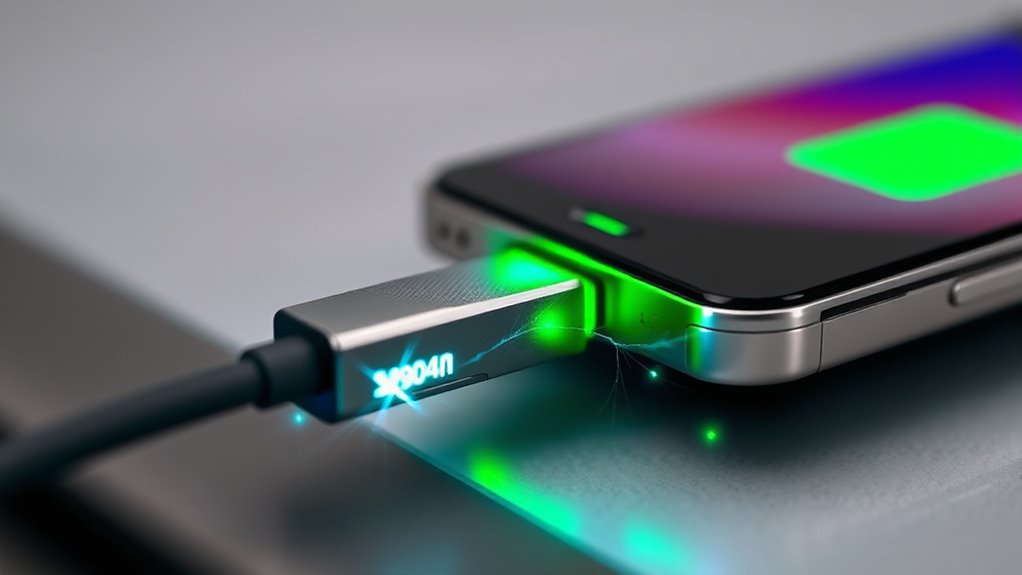
The charger plays a essential role in fast recharge cycles by delivering the precise voltage and high current needed to replenish graphene-based supercapacitors quickly. A dedicated, high-current charger can complete charging in under 30 seconds, enabling rapid energy transfer. During this process, side contacts bypass the battery terminals, ensuring efficiency. Voltage regulation and monitoring are critical to prevent overvoltage, protecting the supercapacitors’ integrity. A regulator circuit steps down the standard 5V supply to the specific voltage, typically around 3.8V, required for fast recharge. This setup guarantees safe, reliable charging cycles.
| Feature | Benefit | Emotion |
|---|---|---|
| Fast recharge | Minimal downtime | Excitement |
| Voltage regulation | Protects supercapacitors | Confidence |
| High-current charger | Rapid energy transfer | Power |
| Side contact design | Efficient energy transfer | Innovation |
Real-World Uses and Potential Applications

Thanks to their rapid charging capabilities, graphene batteries are quickly finding applications in everyday devices like smartphones and laptops, where minimal downtime is essential. Their high energy density and fast recharge times make them ideal for powering electric vehicles and portable electronics.
Graphene batteries enable rapid charging, reducing downtime in smartphones, laptops, and electric vehicles.
Commercial prototypes are already demonstrating durability comparable to traditional batteries, while ultracapacitors built with graphene are enhancing energy storage systems. These batteries can be recharged in as little as 30 seconds, considerably reducing charging time.
As collaboration with industry leaders grows, scaling production becomes more feasible, expanding potential uses. Graphene batteries’ environmentally friendly nature and ultrafast charging make them promising for various sectors, including automotive applications and consumer electronics.
Their innovative features are set to revolutionize energy storage and device performance.
Future Outlook for Graphene-Enhanced Energy Solutions

Advancements in graphene technology are rapidly transforming the future of energy storage, making ultra-fast charging a realistic possibility. Graphene batteries are projected to enable fast charging in just seconds, which could revolutionize how you power electric vehicles, devices, and renewable systems.
Recent breakthroughs show these batteries can recharge in under 30 seconds, far surpassing traditional lithium-ion options. Industry collaborations, like Skeleton Technologies with KIT, aim to commercialize these innovations within a few years, bridging the gap to widespread adoption.
Improvements in graphene’s high conductivity and flexibility are key to scalable, rapid-charging energy storage solutions. Expect graphene-based batteries and ultracapacitors to become central to future energy strategies, releasing new levels of convenience, efficiency, and sustainability across various sectors.
Frequently Asked Questions
How Fast Can Graphene Batteries Charge?
You might wonder how fast graphene batteries can recharge. They can charge in as little as 15 seconds, which is incredibly fast compared to traditional batteries. This rapid charging is possible because of graphene’s high conductivity and large surface area, allowing electrons to transfer quickly.
With response times around 30 milliseconds, these batteries can replenish energy almost instantly, making them ideal for applications needing quick power boosts.
What Battery Can Charge in Seconds?
You’re asking about a battery that can charge in seconds. With graphene batteries combined with ultracapacitor tech, you can recharge in as little as 15 to 30 seconds.
Their high conductivity and large surface area let electrons move rapidly, enabling near-instantaneous recharging. This innovative technology is transforming how quickly devices, electric vehicles, and smartphones can get powered up, replacing traditional batteries with much faster, more efficient options.
What Is the Downside of Graphene Batteries?
Think of graphene batteries as the shiny new toy everyone’s talking about, but every toy has its flaws. You might find that they struggle to keep their sparkle over time, with capacity fading after repeated use.
Manufacturing high-quality graphene is like chasing rainbows — complex and costly. Plus, environmental concerns and compatibility issues make these batteries a double-edged sword, leaving you wondering if they’re ready to take over your devices.
How Long Does It Take to Charge a Cat Graphene Battery?
You might wonder how long it takes to charge a graphene battery. Thanks to its innovative design, it only takes about 30 seconds to fully recharge, which is incredibly fast compared to traditional batteries.
This rapid charging is possible because of graphene’s high conductivity and flexibility, allowing you to quickly power up your devices or electric vehicle without long waits. It’s a game-changer for convenience and efficiency.
Conclusion
Just like lightning strikes in an instant, graphene batteries promise to revolutionize how you recharge. With their rapid charging capabilities and versatile applications, they’re poised to transform your everyday tech and future energy systems. As research advances, you’ll find yourself benefiting from faster, more efficient power solutions that keep up with your busy life. Embrace this cutting-edge technology, and get ready for a world where recharging is as quick as a flash.









